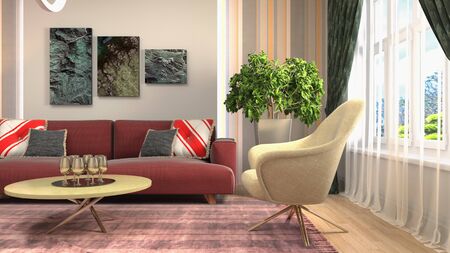Historical Overview of Victorian Interiors
The origins of Victorian interior design in the UK can be traced back to the reign of Queen Victoria, spanning from 1837 to 1901—a period marked by rapid industrialisation, social change, and burgeoning wealth among the middle classes. This era saw a distinct shift in architectural styles and domestic arrangements, as homes became more than just functional spaces; they evolved into reflections of personal taste and social status. Influenced by global trade, technological advancements, and a fascination with history, Victorian interiors drew inspiration from Gothic, Rococo, and Renaissance revivals. The introduction of mass-produced furnishings made ornate décor accessible to a wider audience, encouraging a blend of lavish detail with practical comfort. Socially, there was an emphasis on propriety and formality—parlours and drawing rooms were arranged for entertaining guests, while the separation between public and private spaces within the home became more defined. These cultural and architectural developments laid the foundation for what we now recognise as classic Victorian interiors across the UK.
Architectural Details and Features
Victorian interiors in the UK are renowned for their intricate architectural details, many of which remain highly sought after in period homes today. These features not only reflect the craftsmanship and design sensibilities of the era but also contribute to the distinct character of Victorian properties. Below, we examine some of the most iconic elements found throughout these historic interiors.
Cornicing and Ceiling Roses
Elaborate cornicing and decorative ceiling roses are standout features in Victorian homes, particularly in reception rooms and hallways. Cornicing refers to the ornate plasterwork that runs along the junction between walls and ceilings, often featuring floral or geometric motifs. Ceiling roses, typically positioned at the centre of a room’s ceiling, were originally designed to showcase and support heavy chandeliers or pendant lights. Both details add elegance while emphasising high ceilings—a hallmark of Victorian architecture.
Bay Windows
Bay windows are another hallmark of Victorian design, providing both practical and aesthetic benefits. These windows project outward from the main wall, creating a cosy alcove that maximises natural light and offers panoramic views of the garden or street. In many UK homes, bay windows serve as inviting reading nooks or seating areas, while externally they enhance the property’s façade.
Fireplace Surrounds
No Victorian interior would be complete without a statement fireplace surround. Often crafted from cast iron, marble, or intricately tiled wood, these fireplaces served as focal points in living rooms and bedrooms alike. The combination of decorative mantels and patterned tilework reflects both the era’s love for detail and its focus on warmth and comfort during Britain’s chilly winters.
| Feature | Description | Common Materials | Typical Location |
|---|---|---|---|
| Cornicing | Ornate mouldings at ceiling-wall junctions | Plaster | Reception rooms, hallways |
| Ceiling Roses | Decorative centrepieces for lighting fixtures | Plaster | Ceilings of main rooms |
| Bay Windows | Windows projecting from exterior walls for light and space | Timber, glass | Lounge, dining room, bedrooms |
| Fireplace Surrounds | Decorative frames for fireplaces | Cast iron, marble, tiles, wood | Sitting rooms, bedrooms |
The preservation and restoration of these original features is highly valued among UK homeowners today. For those undertaking renovations, maintaining these details can boost both property value and energy efficiency when paired with modern draught-proofing techniques. Ultimately, these elements embody the timeless appeal of Victorian interiors while offering opportunities for sensitive adaptation to modern living standards.

3. Traditional Victorian Furnishings and Decor
Victorian interiors in the UK are instantly recognisable by their lavish furnishings and intricate decorative elements, reflecting the prosperity and eclectic taste of the era. The quintessential Victorian home is adorned with heavy, dark wood furniture—think mahogany sideboards, ornate bookcases, and button-back armchairs. These pieces often feature elaborate carving and turned legs, echoing the craftsmanship prized during Queen Victoria’s reign.
Fabrics and Textiles
The use of rich textiles is a hallmark of Victorian decor. Luxurious materials such as velvet, damask, and brocade are commonly found on curtains, upholstery, and cushions. Drapes are typically full-length and layered, sometimes complemented by tassels or elaborate tiebacks. Patterned fabrics—particularly those with floral motifs—bring warmth and complexity to living spaces while providing insulation against Britain’s chilly weather.
Colour Palettes
The Victorian colour scheme favours deep, saturated hues. Walls are often painted in shades like burgundy, forest green, navy blue, or ochre. These colours are complemented by gilded picture frames, brass fittings, and accents of cream or gold to create a sense of opulence. Wallpaper is a key feature as well; intricate patterns with botanical or geometric designs were highly fashionable throughout the period.
Decorative Objects
No Victorian interior would be complete without an array of decorative objects. Mantelpieces display ornate clocks, porcelain figurines, and candlesticks, while shelves are lined with leather-bound books and glass-domed curiosities. The fireplace serves as a focal point in most rooms, often surrounded by decorative tiles and adorned with fenders or fire guards for both safety and style. These details combine to create interiors that feel both grand and inviting—a testament to British ingenuity in marrying form with function.
4. Lighting and Flooring in Victorian Homes
Victorian interiors in the UK are instantly recognisable for their atmospheric lighting and distinctive flooring choices, which played a crucial role in setting the mood and character of each room. During the Victorian era, lighting technology evolved rapidly—from candlelight to gas and eventually early electric fixtures. Homeowners were keen to showcase their status with ornate fittings while also embracing new innovations.
Lighting Fixtures: From Gaslights to Chandeliers
In many Victorian homes, grand chandeliers became a central feature in reception rooms and entrance halls. Made from cut glass or brass, these fixtures added both sparkle and sophistication. Wall-mounted sconces and pendant lights were also common, often featuring frosted or stained glass shades that provided a soft glow and complemented the rich colour palettes of Victorian décor. Stained glass windows and lamp shades not only filtered natural light but also introduced vibrant colours into interior spaces, casting beautiful patterns on walls and floors.
Common Lighting Types in Victorian Interiors
| Type | Description | Typical Location |
|---|---|---|
| Chandeliers | Elaborate centrepieces, often with crystal drops or etched glass | Drawing rooms, dining rooms, entrance halls |
| Sconces | Wall-mounted lights with decorative metalwork and glass shades | Corridors, stairways, bedrooms |
| Pendant Lights | Single hanging fixtures, sometimes with stained glass detailing | Kitchens, smaller sitting rooms |
| Lamps with Stained Glass Shades | Table or floor lamps with colourful leaded glass designs | Studies, reading nooks |
Flooring Materials: Patterned Tiles and Polished Wood
The Victorians took pride in robust and decorative flooring. In hallways and porches, encaustic tiles were especially popular—these featured bold geometric or floral patterns in earthy tones, offering both durability and visual impact. Living areas often boasted polished wooden floorboards finished with dark stains for a rich appearance. Luxurious rugs or carpets with intricate motifs provided warmth and comfort underfoot. In kitchens and bathrooms, practical yet stylish options like quarry tiles or mosaic patterns prevailed.
Popular Flooring Choices in Victorian Homes
| Material | Key Features | Usual Placement |
|---|---|---|
| Encaustic Tiles | Colourful clay tiles with inlaid patterns; highly durable | Hallways, entrances, fireplaces surrounds |
| Polished Floorboards | Stained hardwoods (oak, pine) for a formal look; sometimes painted borders | Sitting rooms, bedrooms, studies |
| Mosaic Tiles/Quarry Tiles | Small geometric tiles; practical for wet areas | Kitchens, bathrooms, conservatories |
| Patterned Carpets & Rugs | Wool-based with complex designs (floral or oriental) | Main living spaces, stairs, landings |
Modern Interpretations: Blending Tradition with Efficiency
Today’s homeowners often retain original Victorian lighting features or install period-appropriate reproductions fitted with LED bulbs for energy efficiency. Likewise, reclaimed floorboards or modern encaustic tiles offer traditional aesthetics alongside improved durability and easier maintenance. By combining classic materials with contemporary technology—such as underfloor heating beneath tiled surfaces—UK homes can enjoy both heritage charm and modern comfort while keeping safety and sustainability in mind.
5. Modern Interpretations and Adaptive Uses
Contemporary UK homeowners are increasingly drawn to the charm of Victorian interiors, yet they face the challenge of making these period spaces suitable for modern living. The reinterpretation of Victorian homes often begins with a careful balance: preserving key architectural features such as ornate coving, sash windows, and decorative fireplaces, while introducing practical updates that address today’s needs.
Blending Old with New
A popular approach is to retain original elements—like ceiling roses or timber floorboards—and pair them with sleek, minimal furnishings or open-plan layouts. This contrast not only highlights the craftsmanship of the era but also ensures rooms feel fresh and functional. In kitchens and bathrooms, homeowners might install state-of-the-art appliances and contemporary fittings alongside restored tiles or cast-iron radiators, maintaining period character while improving usability.
Energy Efficiency Upgrades
Victorian properties are notorious for draughts and high energy bills. To tackle this, many opt for discreet double glazing in sash windows, improved insulation under floors, and secondary glazing solutions that preserve the building’s external appearance. Smart thermostats and energy-efficient lighting can be integrated without detracting from historic detailing, offering both comfort and lower running costs.
Safety First
Modern safety standards are another key consideration. Electrical rewiring is often essential in older homes, as is installing up-to-date smoke alarms and carbon monoxide detectors. Where possible, fire doors are fitted sympathetically to match period aesthetics, ensuring compliance without compromising style. Homeowners also pay close attention to secure locks on original doors and windows to meet current insurance requirements.
This thoughtful blending of Victorian heritage with contemporary comfort reflects a wider trend across the UK: embracing the past while prioritising efficiency, safety, and everyday practicality for 21st-century living.
6. Preservation, Upkeep and Safety Tips
Routine Maintenance for Victorian Interiors
Preserving a Victorian property in the UK requires regular attention to both its decorative features and structural integrity. Original plasterwork, ornate cornices, and wooden floors should be checked for signs of damp, cracks, or woodworm. It’s best to use traditional materials and methods for repairs whenever possible to retain authenticity—lime plaster rather than gypsum, and period-appropriate paints or finishes. Schedule annual inspections of roofing, guttering, and sash windows to prevent water ingress, which is a common issue in older homes.
Sustainability and Energy Efficiency
While maintaining period charm, it’s important to improve the energy efficiency of Victorian interiors. Draught-proofing original windows, adding secondary glazing (where permitted), and using heavy curtains can reduce heat loss without compromising heritage value. Consider upgrading insulation in lofts and under floors using materials that allow the building to ‘breathe’, such as sheep’s wool or hemp. Low-energy lighting options like LED bulbs with vintage-style fittings are effective ways to cut electricity bills while complementing period aesthetics.
Modern Safety Standards
Victorian homes often have outdated wiring and plumbing that may not meet current UK building regulations. Engage qualified professionals to inspect electrical systems—rewiring with modern cabling, fitting RCD-protected consumer units, and replacing old fuse boxes ensures safety. For gas appliances and fireplaces, annual servicing by Gas Safe registered engineers is essential. If you have original fireplaces in use, ensure chimneys are swept regularly to prevent fire risk.
Fire Protection Measures
Install smoke alarms on every floor, preferably hardwired and interconnected for maximum protection. Fire doors can be discreetly fitted where necessary—many manufacturers offer options styled to match Victorian panelled doors. Make sure escape routes are clearly marked and unobstructed; this is particularly vital if the property is used commercially or as a rental.
Meeting UK Conservation Guidelines
If your property is listed or within a conservation area, always seek guidance from your local planning authority before undertaking major works or installing new technologies like solar panels or heat pumps. Many councils offer advice on sensitive upgrades that balance heritage preservation with sustainability.
Conclusion: A Sustainable Future for Historic Homes
Caring for Victorian interiors in the UK demands a thoughtful approach—honouring craftsmanship of the past while adapting homes for safe, comfortable modern living. Through proactive maintenance, sensitive updates, and adherence to UK standards, these grand old houses can remain cherished family homes for generations to come.


